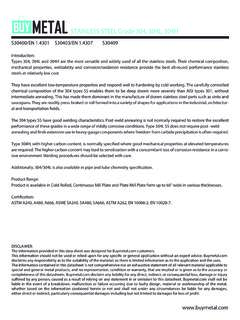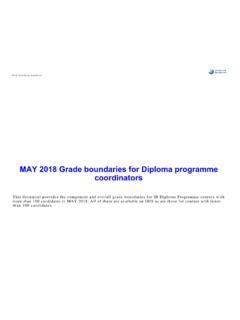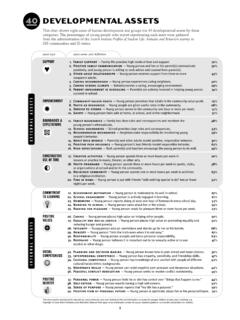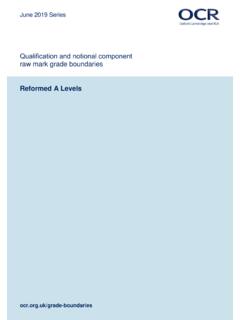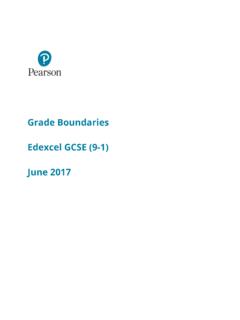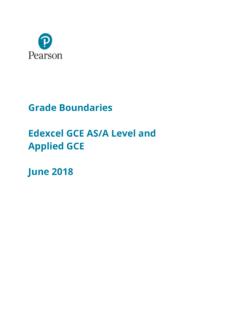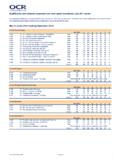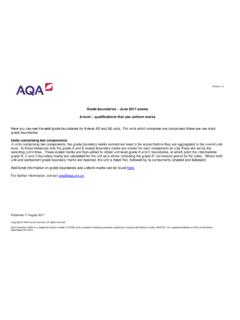Transcription of STAINLESS STEEL Grade 316, 316L
1 STAINLESS STEEL Grade 316, 316L. s31600/EN S31603/EN 1/4404. Introduction: Types 316, 316L are molybdenum-bearing austenitic STAINLESS steels. These steels contain a higher percentage of nickel than 304SS. The resultant composition gives these steels much improved corrosion resistance in many aggressive environments. The molybdenum addition ensures more resistance to pitting and crevice corrosion in chloride-containing media, sea water and chemical environments such as sulfuric acid compounds, phosphoric and acetic acids. The lower rate of general corrosion in mildly corrosive environments gives the STEEL good atmospheric corrosion resistance in polluted marine atmospheres.
2 316 SS offers good strength and creep resistance and also possesses excellent mechanical and corrosion-resistant proper- ties at sub-zero temperatures. 316L is a low-carbon modification of 316. The control of the carbon to a maximum of minimizes the problem of carbide precipitation during welding and permits the use of the STEEL in the as-welded condition in a wide variety of corrosive applications. Additionally, 316/316L is available in pipe and tube chemistry specification. Product Range: Product is available in Cold Rolled, Continuous Mill Plate and Plate Mill Plate form up to 60' wide in various thicknesses.
3 Certification: ASTM A240, A480/09, A666, ASME SA240, SA480, SA666, ASTM A262, EN 10088-2, EN 10028-7. Chemical Composition: UNS/Euro Astm/Euro Carbon Manganese Phosphorous Sulfur Silicon Chromium Nickel Nitrogen Molybdenum S31600 316 max 2 max max max max 16-18 10-14 max 2-3. S31603 316L max 2 max max max max 16-18 10-14 max 2-3. X2 CrNiMo17-12-2 max 2 max max max max 10-13 max X5 CrNiMo17-12-2 max 2 max max max max 10-13 max Mechanical Properties: Tensile Strength min Yeild Strength min Elongation min Hardness max 316 75 ksi 30 ksi 40% 95 HRB. 316L 70 ksi 25 ksi 40% 95 HRB.
4 75 ksi 40%. 75 ksi 40%. Note: Enhanced properties available upon request. STAINLESS STEEL Grade 316, 316L. Properties at elevated temperature: The properties quoted below are typical of annealed 316 only, as strength values for 316L. fall rapidly at temperatures above 800 F. These values are given as a guideline only, and should not be used for design purposes. Short Time Elevated Temperature Tensile Properties: Temperature C. Temperature [ C ] 100 300 500 600 700 800 900 1000 1100. Tensile Strength [MPa] 540 500 480 450 350 205 100 50 25. Proof Stress [MPa] 235 165 145 140 130 115.
5 Elongation [% in 50mm] 52 48 47 44 43 42 63 62 76. Maximum Recommended Service Temperature (In oxidising conditions). Operating Conditions Temperature [ C ]. Continuous 920. Intermittent 870. Representative Creep Rupture Properties: Stress [MPa] to Produce 1% Strain Stress [MN] to Produce Rupture Temperature C 10000 hours 100000 hours 1000 hours 10000 hours 550 225 125 320 270. 600 145 80 220 170. 650 95 55 160 110. 700 65 35 110 70. 750 40 20 75 45. 800 30 15 55 30. 850 20 10 35 20. Properties at Sub-Zero Temperatures The properties quoted below are typical annealed CS316 only Temperature [ C] 20 0 -10 -50 -140 -196.
6 Tensile Strength [MPa] 584 680 832 1105 1136 1360. Proof Stress [MPa] 235 260 336 380 417 444. Elongation [% ] 61 70 69 65 61 58. Impact Energy [J] 170 191 186 183 155 166. STAINLESS STEEL Grade 316, 316L. Physical Properties: The values given below are for 20 C, unless otherwise specified. CS304. Density 8000kg/M . Modulus of Elasticity in Tension 193 GPa Modulus of Elasticity in Torsion 70 GPa Poisson's Ratio Specific Heat Capacity 500J/kgK. Thermal Conductivity: @ 100 C @ 500 C Electrical Resistivity 740n m Mean Co-efficient of Thermal Expansion: 0-100 C m/mk 0-315 C m/mk 0-540 C m/mk 0-700 C m/mk Melting Range 1390-1430 C.
7 Relative Permeability (Note: this Grade is non-magnetic becoming slightly magnetic after cold working). FATIGUE CONSIDERATIONS. When looking into the fatigue of austenitic STAINLESS steels, it is important to note that design and fabrication not material are the major contributors to fatigue failure. Design codes ( ASME) use data from low-cycle fatigue tests carried out on machined specimens to produce conservative S-N curves used with stress concentration factors (11c) or fatigue strength reduction factors (kt). In essence, the fatigue strength of a welded joint should be used for design purposes, as the inevitable flaws (even only those of cross-sectional change).
8 Within a weld will control the overall fatigue performance of the structure. ANNEALING. Annealing of types 316 and 316L is achieved by heating to above 1900 F and for 60 minutes per inch thickness followed by water or air quenching. The best corrosion resistance is achieved when the final annealing temperature is 1950'F_ Controlled atmospheres are recommended in order to avoid excessive oxidation of the surface_ Temperatures above 1975 F are not recommended, except when wire is strand annealed in controlled atmosphere. STRESS RELIEVING. The lower-carbon- Grade 316L can be stress relieved at 850 F to1100 F for 60 minutes with little danger of sensitization.
9 A prolonged heat treatment at these temperatures also results in sigma phase formation and change in the ductility of the material. HOT WORKING. 316 can be readily forged, upset and hot headed. Uniform heating of the STEEL in the range of 2100'F to 2300 F is required_ The finishing temperature should not be below 1650 F_ Upsetting operations and forgings require a finishing, temperature between 1700 F and 1800 F_ Forgings should be air cooled_ All hot-working operations should be followed by annealing, pickling and passivation to restore the mechanical properties and corrosion resistance.
10 STAINLESS STEEL Grade 316, 316L. COLD WORKING. 31613161, types, being extremely tough and ductile, can be readily cold worked such as wire drawing, swaging and cold heading etc. without difficulty. Severe cold forming may require intermediate annealing. MACHINING. Like all the austenitic steels, this alloy group machines with a rough and stringy su-arf. Rigidly supported tools with as heavy a cut as possible should be used to prevent glazing. Buymetal provides 316L Grade bars suitable for machining. WELDING. 316/3161, types have good welding characteristics and are suited to all standard welding methods.
